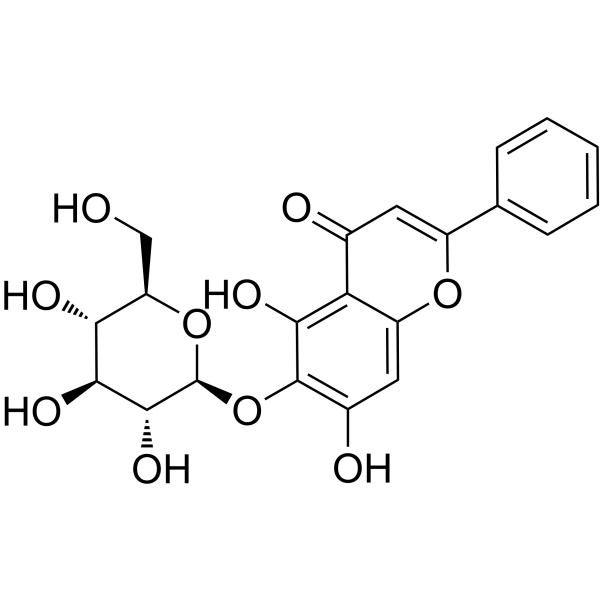
| 规格 | 价格 | 库存 | 数量 |
|---|---|---|---|
| 5mg |
|
||
| Other Sizes |
|
| 靶点 |
Endogenous metabolite; glucuronidated metabolite of Baicalein; Natural flavone
|
|---|---|
| 体内研究 (In Vivo) |
•
口服后,发现黄芩素在肠道中含量丰富。[1]
• 黄芩素的量可以支持其肠道药理活性。[1] • 黄芩素代谢产物在不同肠组织中的成分不同。[1] • 黄芩素的II期代谢产物是小肠中的主要代谢产物。[1] • 肠道微生物群产生的代谢产物在大肠中含量很高。[1] |
| 酶活实验 |
粪便细菌对黄芩素的体外代谢[1]
新鲜小鼠粪便在厌氧环境下完全悬浮在GAM肉汤(10%,w/v)中,然后在37°C的厌氧培养箱中培养24小时。然后将获得的培养物用作小鼠肠道细菌混合物(Xu,赵等人,2014)。将黄酮类化合物溶解在DMSO中,并加入5mL小鼠肠道细菌混合物中。黄芩素和DMSO的最终浓度分别为0.74 mM和2.5%(v/v)。将含有黄酮类化合物和空白GAM肉汤的混合物作为对照。然后将混合物在37°C下厌氧培养24小时。将总共400μL的乙腈/乙酸(9:1,v/v)加入到100μL的混合物中,其中含有74μM的IS。在13000g下离心10分钟后,收集上清液并通过HPLC进行分析。 采用与培养无关的方法来确认结果。粪便微生物群是按照之前发表的方法制备的(Xia等人,2012)。简而言之,在厌氧环境下,收集1克新鲜粪便并悬浮在4°C的9毫升HBSS缓冲液中。将悬浮液在500g下离心5分钟。上清液用作肠道微生物群混合物。后续程序按照上述方法进行。 小鼠肠道和肝脏S9组分对黄芩素的体外代谢[1] 根据之前描述的方法(Ge等人,2018,Xia等人,2012)制备小鼠肠道和肝脏S9组分。 将黄芩素(终浓度,300μM)与小鼠肝脏或肠道S9组分(分别为0.4 mg/mL和2.5 mg/mL,用于葡萄糖醛酸化和甲基化)在含有8 mM MgCl2、25μg/mL甲氧基甲烷和0.4 mM蔗糖内酯的Tris-HCl(0.1μM,pH 7.4)中预孵育;在含有MgCl2(8mM)的Tris-HCl(0.1μM,pH 7.4)中用于甲基化(Fong等人,2012,Zhang等人,2011)。通过添加UDPGA至终浓度2 mM或添加SAM至终浓度400μM来引发反应,并将混合物在37°C下孵育30分钟。[1] 对于脱羟基,500μL的反应混合物含有黄芩素(终浓度为300μM)、Tris-HCl(0.1μM,pH 7.4)、MgCl2(8 mM)、三硝基异柠檬酸(1.43 mg)和异柠檬酸脱氢酶(0.18 U)。通过加入NADP(0.9 mM)和NADPH(0.2 mM)引发反应。反应在37°C下保持30分钟(Xia等人,2007)。[1] 共取出100μL反应混合物,通过加入100μL乙腈/乙酸(9:1,v/v,-20°C)终止反应,其中含有74μM IS。在13000×g下离心10分钟后,收集上清液并通过HPLC-MS/MS进行分析。 蛋白质浓度测量[1] 使用BCA蛋白测定试剂盒,以牛血清白蛋白(BSA)为标准,测量大鼠S9组分的蛋白质浓度。 |
| 动物实验 |
Intestinal pharmacokinetics of baicalein in mice[1]
Thirty-three KM mice were fasted for 16 h with free access to water and were then administrated with 60 mg/kg (222 μmol/kg) baicalein by oral gavage. Three mice were sacrificed at each time point, including 0, 0.25, 0.5, 1, 2, 3, 4, 6, 8, 12, 24 h, and the gastrointestinal tissues were excised and divided into stomach, duodenum, jejunum, ileum, cecum, and colon. The extraction of baicalein metabolites in intestinal tissues was performed according previously published method with minor modification (Lu et al., 2012). After the addition of 1 mL of pre-chilled ethyl acetate and 20 μL of 0.58 M acetic acid solution, the tissues were cut into pieces, homogenized at 4 °C, and ultrasonicated for 5 min. After centrifugation at 12,000g for 10 min, the supernatant was evaporated and the pellet was dried at room temperature. The pellet was resuspended with 800 μL methanol containing 58 μM of acetic acid and 74 μM of internal standard (IS) luteolin. The samples were stored at −70 °C for the subsequent HPLC-MS analysis. Fecal pharmacokinetics of baicalein in mice[1] Three KM mice had free access to both diet and water. After oral administration of 60 mg/kg baicalein, feces were checked and collected every 30 min in 0–12 h time frame; every hour in 12–24 h time frame; every 2 h in 24–60 h time frame, and were combined at 0, 2, 4, 6, 8, 12, 16, 20, 24, 30, 36, 48, and 60 h. The mice litter was frequently changed to maintain a completely dry condition. The extraction of baicalein metabolites in the feces was performed according to previously published method (Xia et al., 2012). Feces samples were weighted, homogenized with 9 volumes (v/w) of methanol containing 58 mM acetic acid and 74 μM IS at 4 °C and the mixture was ultrasonicated for 5 min. After centrifugation at 12000 × g for 10 min, the supernatant was collected and stored at −70 °C for the subsequent HPLC-MS analysis. |
| 参考文献 | |
| 其他信息 |
Baicalein 6-O-glucoside has been reported in Cephalocereus senilis with data available.
|
| 分子式 |
C21H20O10
|
|---|---|
| 分子量 |
432.38
|
| 精确质量 |
432.106
|
| CAS号 |
28279-72-3
|
| PubChem CID |
5321896
|
| 外观&性状 |
Typically exists as solid at room temperature
|
| 密度 |
1.642±0.06 g/cm3
|
| LogP |
0.049
|
| tPSA |
170.05
|
| 氢键供体(HBD)数目 |
6
|
| 氢键受体(HBA)数目 |
10
|
| 可旋转键数目(RBC) |
4
|
| 重原子数目 |
31
|
| 分子复杂度/Complexity |
677
|
| 定义原子立体中心数目 |
5
|
| SMILES |
C1=CC=C(C=C1)C2=CC(=O)C3=C(C(=C(C=C3O2)O)O[C@H]4[C@@H]([C@H]([C@@H]([C@@H](CO)O4)O)O)O)O
|
| InChi Key |
WTYYPLMAODUDGW-QOUKUZOOSA-N
|
| InChi Code |
InChI=1S/C21H20O10/c22-8-14-16(25)18(27)19(28)21(30-14)31-20-11(24)7-13-15(17(20)26)10(23)6-12(29-13)9-4-2-1-3-5-9/h1-7,14,16,18-19,21-22,24-28H,8H2/t14-,16-,18+,19-,21+/m1/s1
|
| 化学名 |
5,7-dihydroxy-2-phenyl-6-[(2S,3R,4S,5S,6R)-3,4,5-trihydroxy-6-(hydroxymethyl)oxan-2-yl]oxychromen-4-one
|
| 别名 |
Baicalein 6-O-glucoside; 28279-72-3; Tetuin; BAicalein 6-O-; A-D-glucopyranoside;
|
| HS Tariff Code |
2934.99.9001
|
| 存储方式 |
Powder -20°C 3 years 4°C 2 years In solvent -80°C 6 months -20°C 1 month |
| 运输条件 |
Room temperature (This product is stable at ambient temperature for a few days during ordinary shipping and time spent in Customs)
|
| 溶解度 (体外实验) |
May dissolve in DMSO (in most cases), if not, try other solvents such as H2O, Ethanol, or DMF with a minute amount of products to avoid loss of samples
|
|---|---|
| 溶解度 (体内实验) |
注意: 如下所列的是一些常用的体内动物实验溶解配方,主要用于溶解难溶或不溶于水的产品(水溶度<1 mg/mL)。 建议您先取少量样品进行尝试,如该配方可行,再根据实验需求增加样品量。
注射用配方
注射用配方1: DMSO : Tween 80: Saline = 10 : 5 : 85 (如: 100 μL DMSO → 50 μL Tween 80 → 850 μL Saline)(IP/IV/IM/SC等) *生理盐水/Saline的制备:将0.9g氯化钠/NaCl溶解在100 mL ddH ₂ O中,得到澄清溶液。 注射用配方 2: DMSO : PEG300 :Tween 80 : Saline = 10 : 40 : 5 : 45 (如: 100 μL DMSO → 400 μL PEG300 → 50 μL Tween 80 → 450 μL Saline) 注射用配方 3: DMSO : Corn oil = 10 : 90 (如: 100 μL DMSO → 900 μL Corn oil) 示例: 以注射用配方 3 (DMSO : Corn oil = 10 : 90) 为例说明, 如果要配制 1 mL 2.5 mg/mL的工作液, 您可以取 100 μL 25 mg/mL 澄清的 DMSO 储备液,加到 900 μL Corn oil/玉米油中, 混合均匀。 View More
注射用配方 4: DMSO : 20% SBE-β-CD in Saline = 10 : 90 [如:100 μL DMSO → 900 μL (20% SBE-β-CD in Saline)] 口服配方
口服配方 1: 悬浮于0.5% CMC Na (羧甲基纤维素钠) 口服配方 2: 悬浮于0.5% Carboxymethyl cellulose (羧甲基纤维素) 示例: 以口服配方 1 (悬浮于 0.5% CMC Na)为例说明, 如果要配制 100 mL 2.5 mg/mL 的工作液, 您可以先取0.5g CMC Na并将其溶解于100mL ddH2O中,得到0.5%CMC-Na澄清溶液;然后将250 mg待测化合物加到100 mL前述 0.5%CMC Na溶液中,得到悬浮液。 View More
口服配方 3: 溶解于 PEG400 (聚乙二醇400) 请根据您的实验动物和给药方式选择适当的溶解配方/方案: 1、请先配制澄清的储备液(如:用DMSO配置50 或 100 mg/mL母液(储备液)); 2、取适量母液,按从左到右的顺序依次添加助溶剂,澄清后再加入下一助溶剂。以 下列配方为例说明 (注意此配方只用于说明,并不一定代表此产品 的实际溶解配方): 10% DMSO → 40% PEG300 → 5% Tween-80 → 45% ddH2O (或 saline); 假设最终工作液的体积为 1 mL, 浓度为5 mg/mL: 取 100 μL 50 mg/mL 的澄清 DMSO 储备液加到 400 μL PEG300 中,混合均匀/澄清;向上述体系中加入50 μL Tween-80,混合均匀/澄清;然后继续加入450 μL ddH2O (或 saline)定容至 1 mL; 3、溶剂前显示的百分比是指该溶剂在最终溶液/工作液中的体积所占比例; 4、 如产品在配制过程中出现沉淀/析出,可通过加热(≤50℃)或超声的方式助溶; 5、为保证最佳实验结果,工作液请现配现用! 6、如不确定怎么将母液配置成体内动物实验的工作液,请查看说明书或联系我们; 7、 以上所有助溶剂都可在 Invivochem.cn网站购买。 |
| 制备储备液 | 1 mg | 5 mg | 10 mg | |
| 1 mM | 2.3128 mL | 11.5639 mL | 23.1278 mL | |
| 5 mM | 0.4626 mL | 2.3128 mL | 4.6256 mL | |
| 10 mM | 0.2313 mL | 1.1564 mL | 2.3128 mL |
1、根据实验需要选择合适的溶剂配制储备液 (母液):对于大多数产品,InvivoChem推荐用DMSO配置母液 (比如:5、10、20mM或者10、20、50 mg/mL浓度),个别水溶性高的产品可直接溶于水。产品在DMSO 、水或其他溶剂中的具体溶解度详见上”溶解度 (体外)”部分;
2、如果您找不到您想要的溶解度信息,或者很难将产品溶解在溶液中,请联系我们;
3、建议使用下列计算器进行相关计算(摩尔浓度计算器、稀释计算器、分子量计算器、重组计算器等);
4、母液配好之后,将其分装到常规用量,并储存在-20°C或-80°C,尽量减少反复冻融循环。
计算结果:
工作液浓度: mg/mL;
DMSO母液配制方法: mg 药物溶于 μL DMSO溶液(母液浓度 mg/mL)。如该浓度超过该批次药物DMSO溶解度,请首先与我们联系。
体内配方配制方法:取 μL DMSO母液,加入 μL PEG300,混匀澄清后加入μL Tween 80,混匀澄清后加入 μL ddH2O,混匀澄清。
(1) 请确保溶液澄清之后,再加入下一种溶剂 (助溶剂) 。可利用涡旋、超声或水浴加热等方法助溶;
(2) 一定要按顺序加入溶剂 (助溶剂) 。